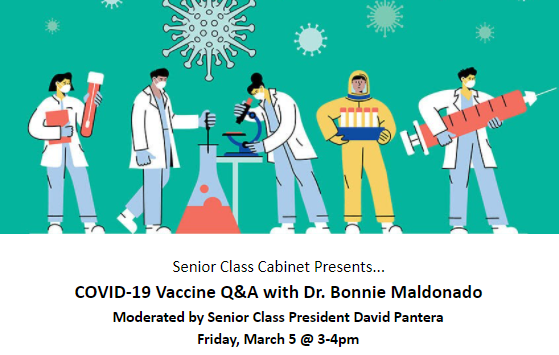The coronavirus vaccine is safe, effective and could be available to college students by summer, Stanford Medicine chief of pediatric infectious diseases Yvonne Maldonado told students during a COVID-19 vaccine Q&A hosted by the Senior Class Cabinet on Friday.
The Pfizer and Moderna vaccines received emergency use authorization from the Food and Drug Administration (FDA) last December, and the Johnson & Johnson vaccine was approved recently on Feb. 27.
“The idea that we would have, let alone one vaccine, but three vaccines in less than a year is really astounding,” Maldonado said. “It’s nothing short of a miracle.”
This record turnaround has raised questions about vaccine safety, but Maldonado emphasized that the vaccine can be trusted.
Pharmaceutical companies have been extremely transparent about posting their study protocols, and Maldonado and her colleagues have reviewed the data submitted to the FDA and other agencies outside of the U.S.
“These studies were done not only as well as other vaccine studies but even better in some ways,” Maldonado said. “And so I feel very confident in these vaccines –– the safety and the efficacy, the way the federal government and especially the CDC and the FDA have monitored adverse events.”
The COVID-19 vaccine studies departed from the norm by ensuring that at least 25% of the subjects were Black, Indigenous and people of color (BIPOC), whereas past studies had fewer opportunities to enroll minority populations, according to Maldonado.
This inclusion was an intentional design component not only to “see if there’s biological differences” in vaccine safety and efficacy in different races, but also to ensure that “people realize that their populations are being represented in studies so that they feel more comfortable” with the vaccine, Maldonado said.
Vaccine side effects and efficacy
While neurologic consequences such as Bell’s palsy or Guillain-Barré syndrome have been associated with a number of other vaccines, there have been no instances of these adverse effects so far in the “millions of [COVID] doses that have been given,” Maldonado said.
Milder side effects like fatigue, aches and pains, headaches and nausea occur in about 20-40% of people and are more common after the second dose, according to Maldonado. There is no “inherent reason” why the vaccine may have longer-term side effects, but the CDC will continue to track safety over time, Maldonado said.
After just the first dose, the degree of protection is as high as 50-80%, with immunity kicking in about two weeks after receiving the injection. It is still unknown whether the first dose alone will “provide enough protection that you’re not going to have to give a second dose,” Maldonado said, but she still recommends getting two doses for the Pfizer and Moderna vaccines to create a more robust and permanent immune response. The Pfizer and Moderna vaccines require two doses, while the Johnson & Johnson vaccine only requires one.
After receiving the full regimen, the Pfizer, Moderna, and Johnson & Johnson vaccines have respective efficacy rates of 95%, 94% and 66% in preventing symptomatic disease, though it is still unclear whether vaccinated individuals are also protected against asymptomatic disease, according to Maldonado.
However, she said that “it is highly likely that getting vaccinated will reduce your propensity to become infected if you’re exposed.” It will likely also reduce chances of infecting other people, an important step toward bringing the U.S. to herd immunity. Seventy to 85% of the population would need to be protected in order to achieve herd immunity.
Future vaccination efforts and challenges
As vaccination rates increase across the country, some companies and large event organizers have said that they will track whether people have received the vaccine because “they’re not going to want to be the source of superspreading,” Maldonado said.
Though Maldonado agrees with mandating vaccines in certain situations like healthcare to protect staff and patients, she said requiring vaccines in general may backfire because “people don’t respond well to mandates; they don’t like being told what to do.”
The focus should not be on mandating vaccines, Maldonado said, but on educating people “to feel comfortable and want to get vaccinated themselves.”
Currently, workers in education and childcare, emergency services and agriculture and food have started receiving vaccinations, joining healthcare workers and those over 65.
The Pfizer vaccine is authorized for people 16 and older, while the Moderna and Johnson & Johnson vaccines can be given to those over 18. A vaccine has yet to be approved for younger children, and Maldonado will be heading a Pfizer pediatric clinical trial at Stanford, starting with children between 12 to 15 years old and gradually moving to children five and older and then six months and older.
“We’re hoping that there will be some vaccines for at least kids between 12 and 15 sometime by the end of the summer, and then maybe for even younger kids after that,” Maldonado said.
Senior class president and event moderator David Pantera ’21 wrote in an email to The Daily, “So much of our future not just as students but also just as members of society is dependent on this vaccine –– its effectiveness, its distribution timeline and its accessibility.”
Pantera added that he hopes this Q&A, which is part of a series of COVID panels hosted by the senior class, will help “fight misinformation, as well as to demystify questions and concerns that might be causing people a great deal of anxiety.”
